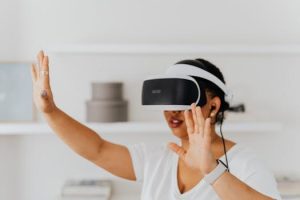The Rise of AR, VR, & MR in Classrooms: Immersive Learning Experiences
The traditional classroom setting has evolved dramatically in recent years due to advancements in technology. The rise of Augmented Reality (AR), Virtual Reality (VR), and Mixed Reality (MR) has paved the way for more immersive and engaging learning experiences. These emerging technologies have introduced a new dimension to education by providing students with a more hands-on, interactive and realistic approach to learning. In this article, we will explore the growing trend of AR, VR, and MR in classrooms and how they are transforming the way students learn, retain information, and prepare for the future.
The Impact of AR, VR, & MR in Education
Augmented Reality, Virtual Reality, and Mixed Reality are three technologies that have been making waves in various industries, and education is no exception. These technologies offer a level of immersion and interactivity that traditional classroom methods cannot match. Transforming from a passive learning experience to an active one, AR, VR, and MR create a more engaging and interactive educational environment for students.
Enhancing Learning Through Immersive Experiences
The main reason why these technologies have gained popularity in education is their ability to provide immersive experiences. With AR, VR, and MR, students can explore and interact with virtual objects in a 3D environment, making the subject matter more engaging and easier to comprehend. This level of immersion goes beyond textbooks and lectures, providing students with real-world scenarios and hands-on learning experiences. This approach to learning encourages critical thinking and problem-solving skills in students, as they are presented with challenges and are actively involved in finding solutions.
Improving Retention of Information
According to research, students retain information better when it is presented in a more interactive and engaging manner. AR, VR, and MR stimulate multiple senses, making the learning experience more memorable. The use of gamification in these technologies also enhances the learning process by making it more enjoyable and practical. By immersing students in a virtual environment, they can apply what they have learned in a practical setting, thus improving their retention of information.
Preparing Students for the Future
The use of AR, VR, and MR in classrooms goes beyond improving the learning experience. These technologies also prepare students for the future by equipping them with the skills necessary for the modern workforce. As more industries adopt AR, VR, and MR, students who are familiar with these technologies will have a competitive advantage in the job market. They will also be better equipped to handle the technology-driven workplace, as they have already been exposed to it through their education.
Integrating AR, VR, & MR into Curriculum
As the benefits of AR, VR, and MR in education become more evident, schools and educators are making efforts to integrate these technologies into their curriculum. With the variety of available applications and software, there are endless possibilities for incorporating AR, VR, and MR into different subjects and grade levels. History classes can come alive with virtual tours of ancient civilizations, science classes can explore the human anatomy in 3D, and language classes can take students on a virtual trip to a foreign country to practice their skills.
Overcoming Challenges
While AR, VR, and MR have numerous benefits, there are also some challenges in implementing these technologies in classrooms. The high cost of equipment and the need for specialized training for educators are some of the barriers schools face in adopting these technologies. However, with the increasing demand for skilled workers in the technology industry, many organizations and companies are offering support and funding to schools and educators to overcome these challenges.
The Future of Education with AR, VR, & MR
The use of AR, VR, and MR in classrooms is still in its early stages, but the potential for growth is vast. With the advancements in technology, these technologies are becoming more affordable and accessible, making it easier for schools to adopt them. As the demand for a more engaging and interactive learning experience grows, the use of AR, VR, and MR in education will undoubtedly become more prevalent. This will not only transform the way students learn but also have a significant impact on the education system as a whole.
Conclusion
The integration of AR, VR, and MR in classrooms has opened doors to a new and better way of learning. These technologies offer a more hands-on, interactive, and engaging approach, improving the learning experience for students. As schools and educators continue to embrace and integrate AR, VR, and MR into their curriculum, the impact on education will only continue to grow. It is safe to say that the future of education is immersive, and AR, VR, and MR are at the forefront of this revolution.







